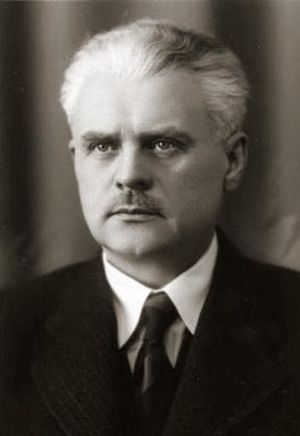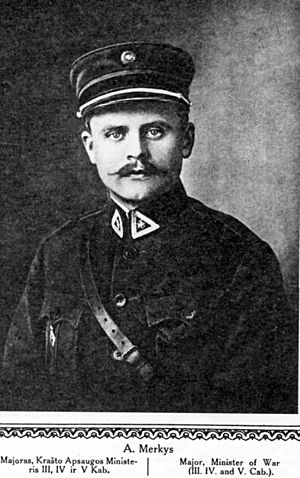Antanas Merkys facts for kids
Quick facts for kids
Antanas Merkys
|
|
|---|---|
 |
|
| de facto acting President of Lithuania | |
| In office 15 June 1940 – 17 June 1940 |
|
| Preceded by | Antanas Smetona |
| Succeeded by | Justas Paleckis |
| 14th Prime Minister of Lithuania | |
| In office 21 November 1939 – 17 June 1940 |
|
| Preceded by | Jonas Černius |
| Succeeded by | Justas Paleckis |
| Personal details | |
| Born | 20 January 1887 Bajorai, near Skapiškis, Kovno Governorate, Russian Empire |
| Died | 5 March 1955 (aged 68) Vladimir Oblast, Russian SFSR, Soviet Union |
| Nationality | Lithuanian |
| Political party | Lithuanian Nationalist Union |
| Relations | Father: Karolis Merkys Mother: Ona Plukaitė-Merkienė |
| Alma mater | Saint Vladimir University |
| Occupation | Politician, lawyer |
Antanas Merkys (born 20 January 1887 – died 5 March 1955) was an important political figure in Lithuania. He was the last Prime Minister of independent Lithuania, serving from November 1939 to June 1940.
In June 1940, the Soviet Union gave Lithuania a very strong demand, called an ultimatum. They wanted to bring their soldiers into Lithuania. The President at the time, Antanas Smetona, left the country. This meant Merkys became the acting president for a short time.
Merkys then handed over power to Justas Paleckis after only three days. Later, Merkys tried to leave Lithuania but was caught. He was sent away to Russia, where he passed away in 1955.
About Antanas Merkys
Antanas Merkys was born in a place called Bajorai, near Skapiškis. He studied law and later joined the Russian Army during World War I (1914–1918).
After the war, Lithuania became an independent country. In 1919, Merkys became Lithuania's Minister of Defence. He served in the Lithuanian Army until 1922, when he left the military and worked as a lawyer.
In 1923, after an event called the Klaipėda Revolt, Merkys worked for the Commissioner of the Klaipėda Region. Later, in 1926, there was a change in government in Lithuania. Merkys became Minister of Defence again until 1927. He then became the Governor of the Klaipėda Region.
In 1932, he was removed from his role as Governor and went back to being a lawyer. From 1933 to 1939, he was the Mayor of Kaunas, a major city in Lithuania. In 1936, he was elected to the Lithuanian Parliament, known as the Fourth Seimas of Lithuania. On 17 November 1939, he became the Prime Minister of Lithuania.
Soviet Demands and Changes in Power
On 14 June 1940, the Soviet Union gave Lithuania a very serious ultimatum. They demanded that Lithuania allow Soviet troops into the country. President Smetona wanted to fight back, but Prime Minister Merkys suggested accepting the demands. Merkys even offered to resign, but he stayed in his role for a bit longer.
Merkys agreed to the Soviet demand to arrest President Smetona, but he couldn't do it. Instead of accepting the demands, Smetona left Lithuania and went to Germany, then to Switzerland. Before leaving, he symbolically gave his presidential duties to Merkys. According to Lithuania's constitution at the time, the Prime Minister would become acting president if the president couldn't do their job.
The very next day after Smetona left, Merkys announced on the radio that he had taken over as president. However, this was against the Lithuanian constitution because Smetona never officially resigned. Because of this, Antanas Merkys is not officially recognized as a true president in Lithuania's history books.
On 17 June 1940, Merkys agreed to more Soviet demands. He sent police to arrest two Lithuanian officials near the border. He also appointed Justas Paleckis as the new Prime Minister. Merkys then resigned later that same day. This made Paleckis the acting president as well. The Soviets then used Paleckis to make their takeover of Lithuania seem legal, and they officially took over Lithuania a month later.
In 1990, when Lithuania declared its independence from the Soviet Union, it stated that Merkys's actions as president were not legal. This meant that everything that led to Lithuania being taken over by the Soviet Union was also not legal. So, Lithuania argued that it was simply regaining its independence, which it believed it never truly lost under international law.
About a month after these events, Merkys tried to escape to Sweden but was arrested in Riga. He and his family were sent away to Saratov in Russia. In 1941, Merkys was put in prison.
In 1954, during a time when the Soviet Union was changing some of its strict rules, Merkys was released from prison. However, he was not allowed to return to Lithuania. He lived in Vladimir until he died on 5 March 1955. His grave could not be found later, but there is a special memorial, called a cenotaph, for him in the Petrašiūnai Cemetery in Kaunas.


